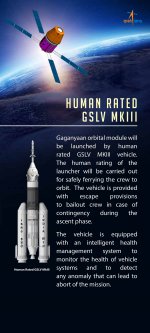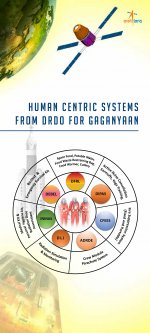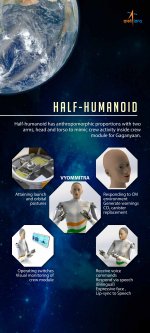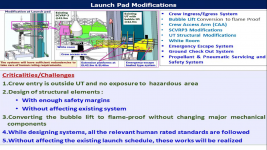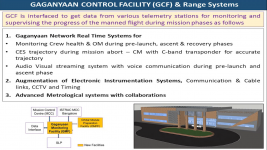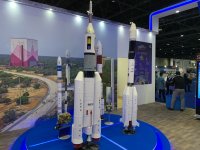Gaganyaan Mission : ISRO to send Indian into space by 2022
- Thread starter Ashwin
- Start date
You are using an out of date browser. It may not display this or other websites correctly.
You should upgrade or use an alternative browser.
You should upgrade or use an alternative browser.
Gaganyaan: Astronauts prepare to start training, ISRO for mission
By Chethan Kumar | TNN | Aug 26, 2021, 08:34 IST
BENGALURU: The four astronaut-elects part of the Gaganyaan program have begun the debriefing process — about their training in Russia — and are gearing up to start the India leg of their training, even as ISRO reviews its preparedness, including the human rating of systems and the launch vehicle.
The four men, all test pilots with the Indian Air Force (IAF) returned from Russia, where they underwent basic astronaut training for a little more than a year, had returned to India earlier this year. While they’ve been based in Bengaluru since their return, they will be required to go to some of the other Indian cities for their training here.
ISRO chairman K Sivan said: “The training is expected to begin in the first week of September. At present the astronauts have begun the process of debriefing. There will be multiple sessions of this before they begin their training.”
As reported by TOI earlier, the National Medical Advisory Council, constituted specifically for the program, has already laid out the protocol to be followed for astronaut training given the pandemic situation.
As part of the first leg of India training the four men will return to their alma mater (IAF) for a two-week flight training, following which they would begin their academic or theory courses. Fitness and other related activities will be a continuous process through their training.
Other Preparations
While the astronaut-elects prepare to begin their training, a long schedule for which is being worked out up to the time of the launch, ISRO is working on putting in place everything else needed for the mission.
While work on human rating of systems, including the launch vehicle (GSLV-Mk3) is progressing as per schedule — revised after the pandemic affected the functioning of ISRO and its vendors — preparations for the launch of two relay satellites, the un-crewed mission etc. are gaining pace.
“If the FAC (failure analysis committee) looking into the GSLV-Mk2 failure from earlier this month concludes that there are some process issues with the cryogenic stage, we may need to revisit some aspects of the Mk3, but that should not affect the program significantly,” a senior scientist said.
Aside from that, work has also begun on the two relay satellites that ISRO will need to launch to be able to track the crew module throughout its orbit in space — it will also be using at least 40 ground stations to track the module.
The first un-crewed mission, as reported by TOI earlier, is now scheduled for mid-2022, following which decisions will be made on how many more such missions may be required before actually launching humans to space. This will, in turn, determine when the human mission could be carried out.
Gaganyaan: Astronauts prepare to start training, Isro for mission - Times of India
By Chethan Kumar | TNN | Aug 26, 2021, 08:34 IST
BENGALURU: The four astronaut-elects part of the Gaganyaan program have begun the debriefing process — about their training in Russia — and are gearing up to start the India leg of their training, even as ISRO reviews its preparedness, including the human rating of systems and the launch vehicle.
The four men, all test pilots with the Indian Air Force (IAF) returned from Russia, where they underwent basic astronaut training for a little more than a year, had returned to India earlier this year. While they’ve been based in Bengaluru since their return, they will be required to go to some of the other Indian cities for their training here.
ISRO chairman K Sivan said: “The training is expected to begin in the first week of September. At present the astronauts have begun the process of debriefing. There will be multiple sessions of this before they begin their training.”
As reported by TOI earlier, the National Medical Advisory Council, constituted specifically for the program, has already laid out the protocol to be followed for astronaut training given the pandemic situation.
As part of the first leg of India training the four men will return to their alma mater (IAF) for a two-week flight training, following which they would begin their academic or theory courses. Fitness and other related activities will be a continuous process through their training.
Other Preparations
While the astronaut-elects prepare to begin their training, a long schedule for which is being worked out up to the time of the launch, ISRO is working on putting in place everything else needed for the mission.
While work on human rating of systems, including the launch vehicle (GSLV-Mk3) is progressing as per schedule — revised after the pandemic affected the functioning of ISRO and its vendors — preparations for the launch of two relay satellites, the un-crewed mission etc. are gaining pace.
“If the FAC (failure analysis committee) looking into the GSLV-Mk2 failure from earlier this month concludes that there are some process issues with the cryogenic stage, we may need to revisit some aspects of the Mk3, but that should not affect the program significantly,” a senior scientist said.
Aside from that, work has also begun on the two relay satellites that ISRO will need to launch to be able to track the crew module throughout its orbit in space — it will also be using at least 40 ground stations to track the module.
The first un-crewed mission, as reported by TOI earlier, is now scheduled for mid-2022, following which decisions will be made on how many more such missions may be required before actually launching humans to space. This will, in turn, determine when the human mission could be carried out.
Gaganyaan: Astronauts prepare to start training, Isro for mission - Times of India

Successful hot Test of Gaganyaan Service Module Propulsion System – System Demonstration Model (SDM)
On August 28, 2021, ISRO successfully conducted the first hot test of the System Demonstration Model (SDM) of the Gaganyaan Service Module Propulsion System for a duration of 450 s at the test facility of ISRO Propulsion Complex (IPRC), Mahendragiri, Tamil Nadu. The system performance met the test objectives and there was a close match with the pre-test predictions. Further, a series of hot tests are planned to simulate various mission conditions as well as off-nominal conditions.
The Service Module is part of the Gaganyaan Orbital module and is located below the crew module and remains connected to it until re-entry. The Service Module (SM) Propulsion System consists of a unified bipropellant system consisting of 5 nos. of 440 N thrust engines and 16 nos. of 100 N Reaction Control system (RCS) thrusters with MON-3 and MMH as Oxidizer and Fuel respectively. The System Demonstration Model (SDM), consisting of 5 nos. of 440 N engines and 8 nos. of 100 N thrusters, was realized to qualify the propulsion system performance in ground. A new test facility is established at IPRC, Mahendragiri for testing the SDM.
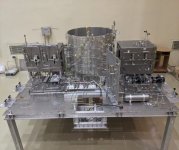
System Demonstration Model (SDM)

System Demonstration Model (SDM) at test bed
Awesome news
View attachment 20696
Successful hot Test of Gaganyaan Service Module Propulsion System – System Demonstration Model (SDM)
On August 28, 2021, ISRO successfully conducted the first hot test of the System Demonstration Model (SDM) of the Gaganyaan Service Module Propulsion System for a duration of 450 s at the test facility of ISRO Propulsion Complex (IPRC), Mahendragiri, Tamil Nadu. The system performance met the test objectives and there was a close match with the pre-test predictions. Further, a series of hot tests are planned to simulate various mission conditions as well as off-nominal conditions.
The Service Module is part of the Gaganyaan Orbital module and is located below the crew module and remains connected to it until re-entry. The Service Module (SM) Propulsion System consists of a unified bipropellant system consisting of 5 nos. of 440 N thrust engines and 16 nos. of 100 N Reaction Control system (RCS) thrusters with MON-3 and MMH as Oxidizer and Fuel respectively. The System Demonstration Model (SDM), consisting of 5 nos. of 440 N engines and 8 nos. of 100 N thrusters, was realized to qualify the propulsion system performance in ground. A new test facility is established at IPRC, Mahendragiri for testing the SDM.
View attachment 20695
System Demonstration Model (SDM)
View attachment 20694
System Demonstration Model (SDM) at test bed
 Kudos to ISRO,
Kudos to ISRO,5 nos. of 440 N thrust engines and 16 nos. of 100 N Reaction Control system (RCS) thrusters. Maybe these thrusters will be connected to the crew module during the re-entry to make the re-entry slower by burning these engines to reduce the speed.
Last edited:
Australia to support ISRO in tracking Gaganyaan mission
ISRO chief K Sivan had said the space agency is also in talks with the Australian counterpart to have a ground station at the Cocos Keeling islands for the Gaganyaan mission.
Press Trust of India
New Delhi
September 15, 2021UPDATED: September 15, 2021 09:46 IST

Australia will support India's Gaganyaan mission by tracking it through Cocos Keeling island, Deputy Head Australia Space Agency Anthony Murfett said on Monday.
Speaking at the International Space Conference organised by the Confederation of Indian Industry (CII), Murfett said the space cooperation between the two countries is on an upswing and the space agencies of India and Australia have recently updated their Memorandum of Understanding.
"We are going to be supporting this Gaganyaan mission by tracking through Australia's territory on the Cocos Keeling islands," he said.
Earlier this year, ISRO chief K Sivan had said the space agency is also in talks with the Australian counterpart to have a ground station at the Cocos Keeling islands for the Gaganyaan mission.
Satellites in orbit cannot pass along their information to the ground stations on Earth if it does not have a clear view of the ground station. A data relay satellite serves as a way to pass along the satellite's information.
There are blind spots due to which there is a possibility of not receiving signals, sources said. The data relay satellite tracking from Cocos Keeling island is expected to help address the issue.
Australia to support Isro in tracking Gaganyaan mission
ISRO chief K Sivan had said the space agency is also in talks with the Australian counterpart to have a ground station at the Cocos Keeling islands for the Gaganyaan mission.
Press Trust of India
New Delhi
September 15, 2021UPDATED: September 15, 2021 09:46 IST

Australia will support India's Gaganyaan mission by tracking it through Cocos Keeling island, Deputy Head Australia Space Agency Anthony Murfett said on Monday.
Speaking at the International Space Conference organised by the Confederation of Indian Industry (CII), Murfett said the space cooperation between the two countries is on an upswing and the space agencies of India and Australia have recently updated their Memorandum of Understanding.
"We are going to be supporting this Gaganyaan mission by tracking through Australia's territory on the Cocos Keeling islands," he said.
Earlier this year, ISRO chief K Sivan had said the space agency is also in talks with the Australian counterpart to have a ground station at the Cocos Keeling islands for the Gaganyaan mission.
Satellites in orbit cannot pass along their information to the ground stations on Earth if it does not have a clear view of the ground station. A data relay satellite serves as a way to pass along the satellite's information.
There are blind spots due to which there is a possibility of not receiving signals, sources said. The data relay satellite tracking from Cocos Keeling island is expected to help address the issue.
Australia to support Isro in tracking Gaganyaan mission
Some upcoming tests/milestones in the Gaganyaan project:
Upcoming IADT of the Crew module will use the Chinook helo:
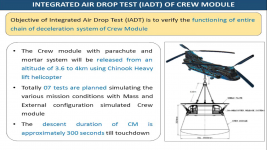
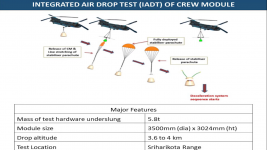
Previous IADT used the IAF's Mi-17 helo:

Pad abort test number 2 (PAT-02):
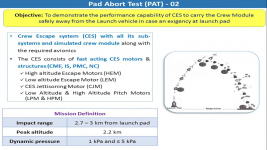
PAT-02 will happen from SRC too like the PAT-01. A new PAT launch pad has been set up there:

PAT-01 test in 2018 :
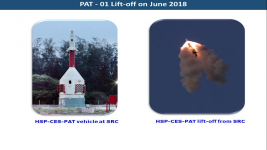
PAT-01 recovery :

Test vehicle project (TVP) to validate the crew escape system during flight. The PAT missions are to demonstrate crew escape system from the launch pad before flight. TVP will use a modified L40 booster from GSLV Mk-2 :
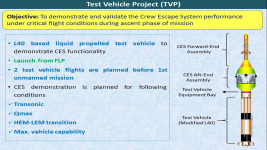
2 TVP flights are planned before Gaganyaan-1 flight. Gaganyaan -1 is scheduled for mid-2022. So the 1st TVP flight should happen by this year.

Continued in next post.....
Upcoming IADT of the Crew module will use the Chinook helo:


Previous IADT used the IAF's Mi-17 helo:

Pad abort test number 2 (PAT-02):

PAT-02 will happen from SRC too like the PAT-01. A new PAT launch pad has been set up there:

PAT-01 test in 2018 :

PAT-01 recovery :

Test vehicle project (TVP) to validate the crew escape system during flight. The PAT missions are to demonstrate crew escape system from the launch pad before flight. TVP will use a modified L40 booster from GSLV Mk-2 :

2 TVP flights are planned before Gaganyaan-1 flight. Gaganyaan -1 is scheduled for mid-2022. So the 1st TVP flight should happen by this year.

Continued in next post.....
Gaganyaan: Astronauts to finish basic aero-med training, then return to Moscow; Viewport mockup arrives
By Chethan Kumar / TNN / Oct 4, 2021, 22:40 IST
The four astronaut-elects shortlisted to be part of India’s first human spaceflight mission — Gaganyaan — are set to complete their training in aerospace medicine at the Indian Air Force’s Institute of Aerospace Medicine (IAM) soon.
Once this training, which will be a basic module, is complete, the astronauts will return to Russia for a brief period.
“Right now they are at IAM. They are being given basic training on aerospace medicine which will be completed by the end of this week.” K Sivan, chairman of ISRO told TOI.
The four men, as reported first by TOI, were at IAF’s Bidar facility in the first week of September to train on fighter planes. This “continuity training” was advised by experts given that the astronaut-elects had been “out of loop for more than a year”.
“...After they complete the IAM module, they will return to Russia for about three weeks. Among activities planned there crew seat moulding, which need to be done as per their body structure. There will also be flight suit trials, including depressurisation checks, etc,” Sivan added.
As reported by TOI earlier, ISRO will be receiving the seats to be used on the crew module from Russia and the space agency has placed orders for four seats, while Russian research, development & production enterprise — Zvezda — will be supplying the space suit.
The four astronaut-elects had, in September 2020, visited Zvezda where their anthropometric parameters were measured for production of spacesuits. “Once they return from Russia, they will begin their second leg of India training beginning with some theory courses,” Sivan said.
Crew Module Viewport
Further, the proposed crew module for Gaganyaan would have a viewport enabling astronauts to view outside and even photograph what they see.
Given ISRO’s lack of expertise in this field, the space agency is looking to import the viewport — basically a three-layered glass structure — and integrate the same with the crew module. Sources in ISRO said that the first set of viewport mockup hardware from Russia has already arrived at ISRO.
“This is mainly meant for checking mechanical interface and other details with our module. It’s only an engineering model. The actual viewport will have three layers of glass. The first layer is meant to deal with thermal protection, the middle layer is for the structure and the inner layer would deal with difference in pressure, etc. That will come later,” Sivan said.
Gaganyaan: Astronauts to finish basic aero-med training, then return to Moscow; Viewport mockup arrives | India News - Times of India
By Chethan Kumar / TNN / Oct 4, 2021, 22:40 IST
The four astronaut-elects shortlisted to be part of India’s first human spaceflight mission — Gaganyaan — are set to complete their training in aerospace medicine at the Indian Air Force’s Institute of Aerospace Medicine (IAM) soon.
Once this training, which will be a basic module, is complete, the astronauts will return to Russia for a brief period.
“Right now they are at IAM. They are being given basic training on aerospace medicine which will be completed by the end of this week.” K Sivan, chairman of ISRO told TOI.
The four men, as reported first by TOI, were at IAF’s Bidar facility in the first week of September to train on fighter planes. This “continuity training” was advised by experts given that the astronaut-elects had been “out of loop for more than a year”.
“...After they complete the IAM module, they will return to Russia for about three weeks. Among activities planned there crew seat moulding, which need to be done as per their body structure. There will also be flight suit trials, including depressurisation checks, etc,” Sivan added.
As reported by TOI earlier, ISRO will be receiving the seats to be used on the crew module from Russia and the space agency has placed orders for four seats, while Russian research, development & production enterprise — Zvezda — will be supplying the space suit.
The four astronaut-elects had, in September 2020, visited Zvezda where their anthropometric parameters were measured for production of spacesuits. “Once they return from Russia, they will begin their second leg of India training beginning with some theory courses,” Sivan said.
Crew Module Viewport
Further, the proposed crew module for Gaganyaan would have a viewport enabling astronauts to view outside and even photograph what they see.
Given ISRO’s lack of expertise in this field, the space agency is looking to import the viewport — basically a three-layered glass structure — and integrate the same with the crew module. Sources in ISRO said that the first set of viewport mockup hardware from Russia has already arrived at ISRO.
“This is mainly meant for checking mechanical interface and other details with our module. It’s only an engineering model. The actual viewport will have three layers of glass. The first layer is meant to deal with thermal protection, the middle layer is for the structure and the inner layer would deal with difference in pressure, etc. That will come later,” Sivan said.
Gaganyaan: Astronauts to finish basic aero-med training, then return to Moscow; Viewport mockup arrives | India News - Times of India
Gaganyaan has opened space to the private sector: Within a decade Indian industry should begin providing space tourism too
By Chethan Kumar
October 12, 2021, 9:10 PM IST
Last month, GoI approved the formation of the board for IN-SPACe, a single-window nodal agency that is mandated to help propel the country’s space sector into its next phase. Of course at present a lot of anticipation is tied to Gaganyaan, India’s first human spaceflight mission. ISRO chairman K Sivan and S Unnikrishnan Nair, director, ISRO Human Space Flight Centre, spoke to Chethan Kumar about preparations for the mission:
What does Gaganyaan represent for India ?
Sivan: Gaganyaan has a multifold objective. First and foremost is to demonstrate India’s capability to send humans to space and bring them back safely. There are many technological developments needed for Gaganyaan, which will allow India to gain knowledge of such technologies. Launching satellites itself is a very complex job, and putting humans in space is even more complex, needing several advanced technologies. These will provide spinoffs for the private sector for commercial use.
As it was envisaged, this program is not related to ISRO alone, there are a lot of organizations that are involved. And there are international collaborations which add to our diplomacy efforts too. In the next decade or two, permanent presence of humans in space will become a necessity. We have to prepare ourselves for that eventuality. Once we are able to demonstrate this, we will be able to collaborate with foreign agencies at the same level.
What are the major systems developed for Gaganyaan ?
Unni: The first major technology is the human rating of the launch vehicle – the GSLV-Mk3. Most activities have been completed and the testing phase is progressing where we are checking for the robustness of systems. We’ll also need an integrated vehicle health management system which can assess the vital performances and parameters efficiently. It should only abort after taking complete stock of parameters accurately. Then there’s the crew escape system, which has also entered the testing phase.
The main system is the crew module which has a twin-walled structure that has to go into space, survive the pressure there, withstand the rigors of re-entry and splash down. This is also in the realization phase. The crew module, along with the service module, will form the orbital module. Then we need the environmental control and life support system that mimics the Earth atmosphere, which comprises thermal control system, cabin air revitalization system, pressure control systems etc., all of which have completed the design phase and some systems are undergoing testing.
How will both Gaganyaan and the opening up of the space sector help India grow ?
Sivan: When we speak of Gaganyaan, there are a lot of new technologies being developed that will eventually help in the permanent presence of humans in space. Our announcement of opportunities for the human space program has seen a tremendous response. I believe we have opened up the sector at the right time. The industry will not only be involved in production but also develop advanced technologies for future programs. Once they have this, I’m sure that at some point, they would be able to launch humans by themselves. That day is not too far. Maybe 10 years from now, I won’t be surprised if I see Indian industry involved in human space program like Elon Musk.
Unni: If you look at other countries many commercial players are already involved and I hope our industry will also cash in on this, especially when we speak of space tourism, which need not involve crew actually staying in or orbiting. Space tourism is just crossing the Karman Line, experiencing zero gravity and returning. The industry is already developing some complex systems that are in the testing phase.
Speaking of prolonged human presence in space, what’s the status of the proposed space station ?
Sivan: ISRO always works in advance. We begin working on technologies and systems before going into project mode, which is only done after we’ve achieved the required level of maturity. We did the same with Gaganyaan. For the space station, work is going on in the background, including on technologies for space docking. Some of it will be tested in the coming years. Once we attain the maturity needed, we’ll get into project mode.
Gaganyaan has opened space to the private sector: Within a decade Indian industry should begin providing space tourism too
By Chethan Kumar
October 12, 2021, 9:10 PM IST
Within a decade Indian industry should begin providing space tourism too.
Last month, GoI approved the formation of the board for IN-SPACe, a single-window nodal agency that is mandated to help propel the country’s space sector into its next phase. Of course at present a lot of anticipation is tied to Gaganyaan, India’s first human spaceflight mission. ISRO chairman K Sivan and S Unnikrishnan Nair, director, ISRO Human Space Flight Centre, spoke to Chethan Kumar about preparations for the mission:
What does Gaganyaan represent for India ?
Sivan: Gaganyaan has a multifold objective. First and foremost is to demonstrate India’s capability to send humans to space and bring them back safely. There are many technological developments needed for Gaganyaan, which will allow India to gain knowledge of such technologies. Launching satellites itself is a very complex job, and putting humans in space is even more complex, needing several advanced technologies. These will provide spinoffs for the private sector for commercial use.
As it was envisaged, this program is not related to ISRO alone, there are a lot of organizations that are involved. And there are international collaborations which add to our diplomacy efforts too. In the next decade or two, permanent presence of humans in space will become a necessity. We have to prepare ourselves for that eventuality. Once we are able to demonstrate this, we will be able to collaborate with foreign agencies at the same level.
What are the major systems developed for Gaganyaan ?
Unni: The first major technology is the human rating of the launch vehicle – the GSLV-Mk3. Most activities have been completed and the testing phase is progressing where we are checking for the robustness of systems. We’ll also need an integrated vehicle health management system which can assess the vital performances and parameters efficiently. It should only abort after taking complete stock of parameters accurately. Then there’s the crew escape system, which has also entered the testing phase.
The main system is the crew module which has a twin-walled structure that has to go into space, survive the pressure there, withstand the rigors of re-entry and splash down. This is also in the realization phase. The crew module, along with the service module, will form the orbital module. Then we need the environmental control and life support system that mimics the Earth atmosphere, which comprises thermal control system, cabin air revitalization system, pressure control systems etc., all of which have completed the design phase and some systems are undergoing testing.
How will both Gaganyaan and the opening up of the space sector help India grow ?
Sivan: When we speak of Gaganyaan, there are a lot of new technologies being developed that will eventually help in the permanent presence of humans in space. Our announcement of opportunities for the human space program has seen a tremendous response. I believe we have opened up the sector at the right time. The industry will not only be involved in production but also develop advanced technologies for future programs. Once they have this, I’m sure that at some point, they would be able to launch humans by themselves. That day is not too far. Maybe 10 years from now, I won’t be surprised if I see Indian industry involved in human space program like Elon Musk.
Unni: If you look at other countries many commercial players are already involved and I hope our industry will also cash in on this, especially when we speak of space tourism, which need not involve crew actually staying in or orbiting. Space tourism is just crossing the Karman Line, experiencing zero gravity and returning. The industry is already developing some complex systems that are in the testing phase.
Speaking of prolonged human presence in space, what’s the status of the proposed space station ?
Sivan: ISRO always works in advance. We begin working on technologies and systems before going into project mode, which is only done after we’ve achieved the required level of maturity. We did the same with Gaganyaan. For the space station, work is going on in the background, including on technologies for space docking. Some of it will be tested in the coming years. Once we attain the maturity needed, we’ll get into project mode.
Gaganyaan has opened space to the private sector: Within a decade Indian industry should begin providing space tourism too



